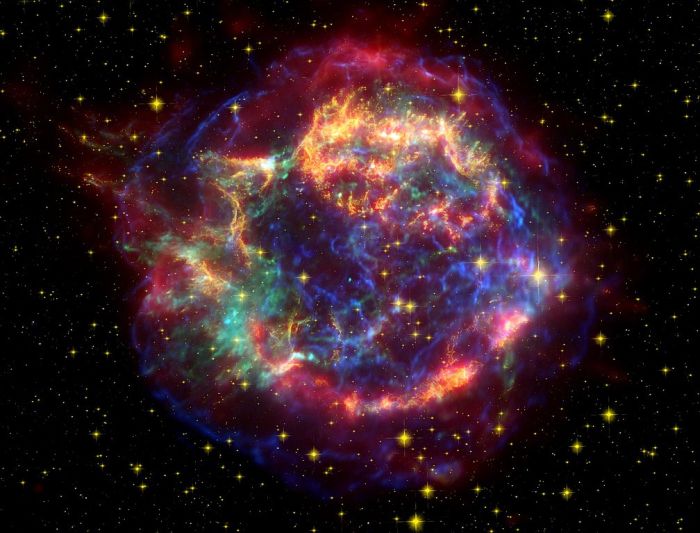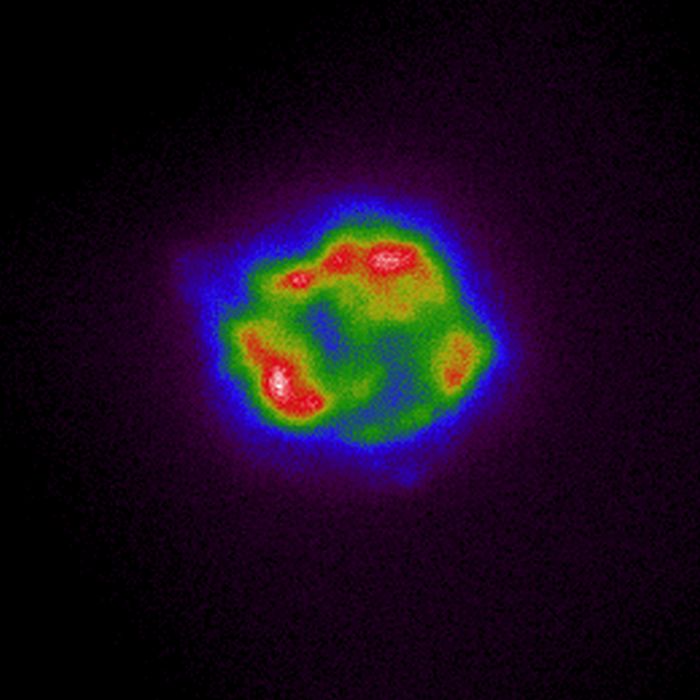A new telescope designed to peer into the twisted X-ray Universe has just sent back its first-ever imaging data.
The Imaging X-Ray Polarimetry Explorer (IXPE), a joint project between NASA and the Italian Space Agency, fixed its gaze on one of the most famous explosions in the Milky Way: Cassiopeia A.
Located 11,000 light-years away, it's the expanding remnant of a star thought to have been observed exploding in the 1690s, and it's one of the most well-studied objects in the Milky Way, for good reason – it has provided some invaluable insight into supernovae.
Cassiopeia A emits light in multiple wavelengths, including radio, optical, and, of course, X-rays. In fact, the first science image from another of NASA's X-ray observatories, Chandra, was also Cassiopeia A.
 A 2005 composite of Cassiopeia A combining data from Hubble, Spitzer, and Chandra. (NASA/JPL-Caltech)
A 2005 composite of Cassiopeia A combining data from Hubble, Spitzer, and Chandra. (NASA/JPL-Caltech)
But IXPE is showing us the object in a way we haven't seen before.
"The IXPE image of Cassiopeia A is as historic as the Chandra image of the same supernova remnant," says astronomer and IXPE principal investigator Martin C. Weisskopf of NASA's Marshall Space Flight Center.
"It demonstrates IXPE's potential to gain new, never-before-seen information about Cassiopeia A, which is under analysis right now."
There's a lot going on in Cassiopeia A. Before it died, the precursor star was a massive object that, as it ran out of fuel, became unstable, ejecting its outer layers to create a cloud of circumstellar material. When the supernova finally did take place, therefore, the shock wave was not entering pristine space, but a relatively dense cloud.
The shocks and magnetic fields that emerge from this intense environment can create synchrotrons that accelerate electrons, generating high-energy X-radiation.
Chandra has performed fascinating probes; combining Chandra data with light in other wavelengths, for example, has allowed astronomers to map the different elements in Cassiopeia A that were spewed out during the giant explosion.
IXPE is designed specifically to study the way X-rays are polarized. When light is emitted from a source, its waves are oriented in all directions. When that light encounters a medium, that can change.
Passing through gas, for instance, can absorb some orientations. Bouncing off things can also alter the orientation of some wavelengths. We call this effect polarization.
For an object such as Cassiopeia A, detailed polarization data will tell us more about the environment inside the supernova remnant. It will reveal more information about how light is being absorbed and reflected, and the tangle of magnetic fields produced by a supernova.
 IXPE's X-ray light intensity map of Cassiopeia A. (NASA)
IXPE's X-ray light intensity map of Cassiopeia A. (NASA)
"IXPE's future polarization images should unveil the mechanisms at the heart of this famous cosmic accelerator," says astronomer Roger Romani of Stanford University.
"To fill in some of those details, we've developed a way to make IXPE's measurements even more precise using machine learning techniques. We're looking forward to what we'll find as we analyze all the data."
The telescope, from its position in low-Earth orbit, will also probe the polarization of X-rays from some of the most energetic sources in the Milky Way and the wider Universe beyond. That includes neutron stars, pulsars, magnetars, black holes, and quasar galaxies that shine with some of the brightest light in the Universe. IXPE will also map light intensity, time of arrival, and position in the sky.
Cassiopeia A is an excellent place to start.
"The IXPE image of Cassiopeia A is bellissima," says astronomer and IXPE principal investigator Paolo Soffitta of the National Institute of Astrophysics (INAF) in Italy, "and we look forward to analyzing the polarimetry data to learn even more about this supernova remnant."







No comments:
Post a Comment